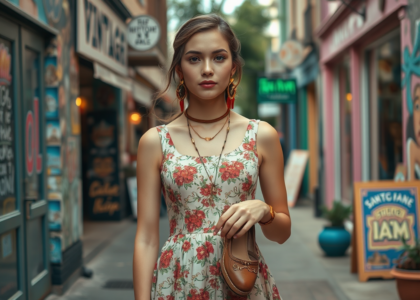Fashion and architecture, seemingly disparate disciplines, share a surprising number of similarities. Both are deeply concerned with form, structure, and space, and both strive to balance aesthetics with functionality. This article will delve into the intertwined history and symbiotic relationship between these two fields, exploring how they influence and inspire each other.
The Historical Connection

The connection between fashion and architecture dates back centuries. In ancient civilizations, such as Egypt and Greece, the design principles used in architecture were reflected in the garments of that time. For instance, the columns and drapery of Greek temples found parallels in the pleats and folds of Greek togas. This historical link demonstrates that both fields have long shared a common language of design, emphasizing proportion and harmony.
Moreover, during the Renaissance, architects and fashion designers alike were inspired by the ideals of symmetry and balance. Leonardo da Vinci, for example, applied his architectural knowledge to the design of costumes, blending form with function. This era saw a flourishing of creativity where the dialogue between fashion and architecture grew more profound.
Modern Symbiosis
In contemporary times, the relationship between fashion and architecture has evolved into a dynamic and collaborative exchange. The advancements in materials and technology have allowed both fields to push the boundaries of traditional design. Architects such as Zaha Hadid and fashion designers like Iris van Herpen exemplify this modern symbiosis, creating works that are both visually stunning and ingeniously constructed.
For example, Hadid’s architectural designs often feature flowing, organic forms that also appear in van Herpen’s avant-garde clothing pieces. Both visionaries utilize innovative techniques and materials to create structures and garments that redefine conventional aesthetics. This cross-pollination of ideas enriches both fields, fostering a continuous evolution of creative expression.
Fashion and architecture are governed by several shared design principles. Here are a few key principles that illustrate their interconnectedness:
-
Proportion and Scale:
Both disciplines require a keen understanding of proportion and scale to ensure that a building or garment fits comfortably and functions effectively. -
Form and Function:
While aesthetics are paramount, both fields must also prioritize usability and practicality. -
Materiality:
Selecting the right materials is crucial to the success of both a garment and a building. Textures, durability, and sustainability are all considered in the design process.
These principles highlight the complementary nature of fashion and architecture, where the attributes of one can inform and enhance the other. The emphasis on innovation within both fields continues to bridge the gap between them, resulting in groundbreaking designs that captivate and inspire.
Technology and Innovation
Technology plays a pivotal role in the convergence of fashion and architecture. The advent of 3D printing, for instance, has revolutionized both industries. Architects use 3D printing to create complex models and components for their buildings, while fashion designers employ the same technology to craft intricate textiles and accessories.
Furthermore, sustainability is a significant concern in both fields, prompting designers to explore eco-friendly materials and methods. Innovations such as recycled fabrics and green building practices not only benefit the environment but also set new standards for ethical design. This shared commitment to sustainability further cements the relationship between fashion and architecture.
The Influence on Lifestyle and Culture
The interplay between fashion and architecture extends beyond aesthetics and functionality; it also profoundly influences lifestyle and culture. Architectural landmarks often become cultural symbols, much like iconic fashion pieces, shaping the identity and character of a city or era. The Eiffel Tower in Paris and the little black dress by Coco Chanel are prime examples of how design can leave a lasting cultural impact.
Fashion and architecture both serve as mediums of self-expression and cultural commentary. They reflect societal values, trends, and aspirations, offering insights into the collective consciousness of a time and place. As such, their relationship continues to shape and be shaped by the evolving cultural landscape.
Conclusion
In conclusion, the relationship between fashion and architecture is a testament to the interplay of form, function, and creativity. Their shared history, design principles, and technological advancements underscore their interconnectedness. From influencing cultural symbols to championing sustainability, fashion and architecture together craft a richly woven tapestry of human expression and innovation.
FAQs
1. How have technological advancements impacted the relationship between fashion and architecture?
Technological advancements like 3D printing and sustainable materials have enabled both fashion and architecture to explore new forms and functionalities, fostering a closer relationship between the two fields.
2. Can fashion influence architectural design, and vice versa?
Yes, fashion can influence architectural design and vice versa. Both fields draw on similar design principles, such as proportion, materiality, and aesthetics, often inspiring innovations that blur the boundaries between the two.
3. Are there any famous examples of collaborations between fashion designers and architects?
One famous collaboration is between architect Zaha Hadid and fashion designer Karl Lagerfeld. Their partnership resulted in the Chanel Mobile Art Pavilion, an embodiment of the synergy between architectural form and fashion design.
4. How do fashion and architecture reflect cultural trends?
Both fashion and architecture serve as mirrors to societal values, trends, and aspirations. They capture and reflect the cultural zeitgeist, each in their unique way, influencing how people perceive and engage with their environment.
5. What common challenges do fashion designers and architects face?
Fashion designers and architects often face similar challenges, such as balancing aesthetics with functionality, selecting sustainable materials, and navigating the constraints of budgets and timelines, all while striving to innovate and push creative boundaries.










